Disclosure: Meeple Mountain received a free copy of this product in exchange for an honest, unbiased review. This review is not intended to be an endorsement.
Darwin’s Journey, On the Origin of Species (the game), Darwin’s Choice, Darwinauts… Charles Darwin—world-renowned naturalist, botanist, geologist, author of On the Origin of Species—is a hot commodity in board gaming these days. It’s no wonder either. Darwin’s journey on the HMS Beagle, exploring distant lands, chronicling what he’s seeing, and ultimately postulating the theory of evolution by natural selection are all aspects of the Darwin phenomenon that are easily gamified. And these games tend to fall squarely into one of two categories: vaguely historical re-enactments of Darwin’s journey or games that are more about evolution than they are about Darwin himself.
In the Footsteps of Darwin isn’t about either of those things. It’s a game that imagines what comes after. The year is 1856 and Charles Darwin’s adventuring days are long behind. His seminal work On the Origin of Species is still a work in progress. It’s been 20 years since the Beagle’s voyage across the lower half of the globe drew to a close, and Darwin’s eye has turned to the upper half. Not fully satisfied that he’s gathered enough evidence to support his theory, he’s tapped a new generation of explorers to gather data about these distant lands for him.
Specifically, he’s chosen you.
The HMS Beagle Sails Again!
In the Footsteps of Darwin is a tile drafting game with a bit of set collection thrown in and a whole lot of point salad.
In between the players is a grid of randomly drawn tiles featuring various animals from different regions of the globe. Players take turns moving the Beagle around the outside of this grid in order to draft tiles from the row or column which the ship occupies. The tiles they draft are then placed into the matching area of their Player board.
Each Player board is divided into a grid with each column representing a specific region—The Americas, Africa, Asia, and Oceania— and each row representing a different type of animal—Arthropod, Mammal, Reptile, and Bird. As players complete rows or columns, they write publications, which are worth end-of-game points. As they claim animal tiles and set them atop animal tiles of the same type, they publish theories which are personal, end-of-game objectives that are worth even more points. Each animal also provides a benefit of some kind when it is placed into a player’s tableau.
Players also draw inspiration from the various real-world figures which sprout up over the course of the game. When these are drafted, they provide the players with their unique gifts for the remainder of the game.
Once each player has drafted and placed exactly twelve tiles, the game comes to an end and the scores are tallied to determine the winner.
Of course, this is a high-level overview of the game. If you think you’ve got a decent idea of how the game works and just want to know what I think, feel free to skip ahead to the Thoughts section. Otherwise, read on as we learn how to play In the Footsteps of Darwin.
Stowing Your Gear
A game of In the Footsteps of Darwin is set up thusly:

The Journey board is placed between the players. The Animal and Character tiles are shuffled together and placed close by in several face down stacks. Then, twelve tiles are drawn at random and placed into the grid on the Journey board. The Beagle figurine is placed at the top of the middle column of tiles.
The Theory tiles are shuffled together and placed into two face down stacks and placed into their indicated locations. Three of these are placed face up beneath them. All the Compass, Guide, and Publication tokens are placed into their associated storage areas along the left side of the Journey board.
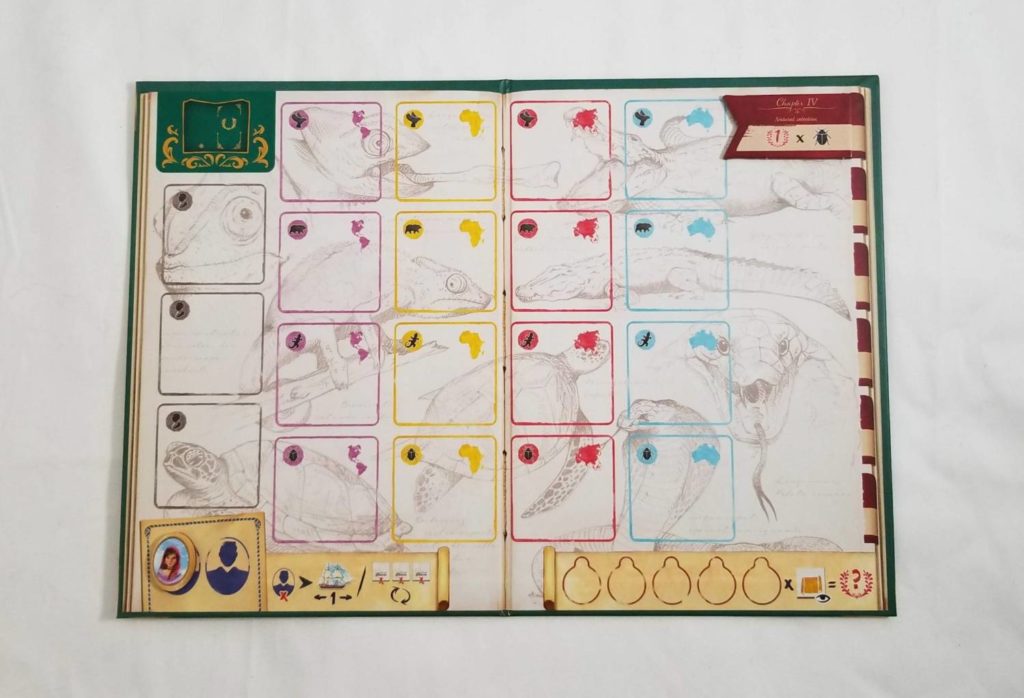
Next, each player receives a Naturalist’s notebook (player board) along with a Guide token and a randomly dealt Theory tile from the top of one of the Theory tile decks. The Guide token is placed into one of the indicated locations on the bottom left of the board and the Theory tile is placed face up into one of the empty positions running along the right edge of the board.
Then, a starting player is selected by some means, given the Darwin standee, and you’re ready to begin playing In the Footsteps of Darwin.
Anchors Aweigh
On your turn, you’ll look at the row or column on whose edge the Beagle figurine sits, select a tile to place onto your player board, and then move the Beagle figurine clockwise around the edge of the tile grid, according to which position the selected tile sat. Then a new tile is drawn from one of the stacks and placed, face up, into the newly emptied location. You can also discard one of your Guide tokens to move the Beagle forward or back one position before selecting your tile. Additionally, Guide tokens can be discarded to wipe and replace the entire row or column of tiles which the Beagle is facing.
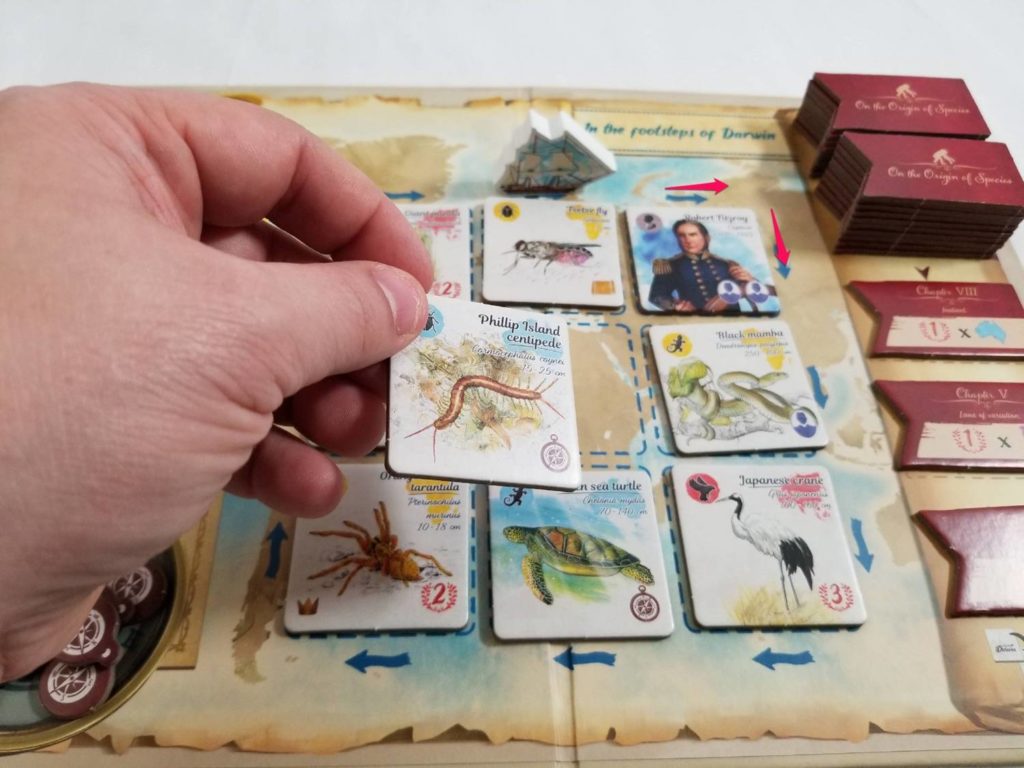
For instance, if you selected the Phillip Island Centipede tile which is sitting two tiles away from the Beagle, you’d place the Phillip Island Centipede into the Oceania arthropod position on your player board (the Oceania column and the arthropod row), move the Beagle two positions clockwise around the edge of the tile grid (because the Centipede tile was two tiles away), and draw a new tile. Then, it would be the next player’s turn.

The turn structure in In the Footsteps of Darwin couldn’t be any simpler. The real challenge comes from deciding which tiles to draft, and when. There are, of course, several factors to weigh when making these decisions.
Study and Inspiration
The choice of which Animal tiles you draft will be mostly driven by where they fit into your player board. If you’re getting close to finishing up a row or a column, then going after Animal tiles that can accomplish that is a no-brainer. Publication tokens are worth five points each.
But there are other considerations. Most animals, in addition to their region/type combo, also provide the player with some kind of bonus. Some are instantaneous (acquire a Guide token, for instance), some are worth straight up victory points at the end of the game, and others combo together for potential massive point gains at the game’s end (the number of collected Chart icons times the number of Compass tokens you’ve collected).
Additionally, any time you stack a creature tile on top of another one, you acquire one of the face up Theory tiles (or a random face down one) from the Journey board and add it to your own. These will score you points based on how well you met their criteria (two points for every African creature, for instance). So, that’s another consideration.
Less of a consideration are the five Character tiles. Each of these provides two benefits each, a Guide token, plus one of the following: another Guide token, a Compass symbol, a Chart symbol, four victory points, a Theory tile, or the Darwin standee (which is worth two points to whoever holds it at the end of the game). Even though these aren’t as useful as the Animal tiles overall, they can still come in handy in the right situations. Players can only ever acquire three of them. Oddly enough, there isn’t a single Theory tile that rewards you for having collected Character tiles. An oversight perhaps? Or maybe fodder for a future expansion?
Regardless, once you’ve picked up twelve tiles, the game’s over. So, make your selections count.
Thoughts
There’s a strange irony about Darwin-theme games in that they owe their existence to the subject matter presented inside of them. In a world where thousands of new games hit the market every single year, it’s incredibly rare to see something that hasn’t been done before in some form or fashion. Each game exists because some other idea that worked before is being improved upon, while those that didn’t were ultimately rejected, a sort of board game evolution.
Consider the way the Beagle moves around the tile display on the Journey board. This is a mechanic I’ve seen before in games like Maori, Cottage Garden, and Merv: Heart of the Silk Road. The interesting thing is how each game innovates upon the concept. Maori uses any boat icons you’ve collected to determine how far you can move the boat and, much like the Guide tokens in this game, you’re able to expend shells to extend your reach. In Cottage Garden, the boat is replaced by a die which increases in pip value each rotation around the board, acting as the game timer. Merv doesn’t allow players to turn corners, limiting your options to the rows or columns the players before you have not selected. The position of the row or column you’ve chosen ultimately determines the turn order for the next round.
The Beagle’s movement brings to mind all the games that have come before, but it still manages to feel unique. Few games really get me mulling over the source material the way this one does. Part of that is the pure evolution of it all, but a larger part is that In the Footsteps of Darwin is positively jam-packed with historical context. The first two pages of the rule book are dedicated to Darwin’s backstory, and historical facts are sprinkled throughout. And, as if that weren’t enough, there’s even a separate Appendix in the box that, by turning the Journey board to its Appendix side, you can follow along with as you read about the various steps of Darwin’s historic journey. There are even facts presented about each and every creature in the game.

In my review of Lewis and Clark: the Expedition, I waxed poetic about how much I love this kind of thing. While completely unnecessary, it’s just amazing to have. If I weren’t sucked into the Darwin-driven narrative before opening this game box or the first time, I sure am now. That guy had a fascinating life!
The rest of the components are just as lovely. The artwork, with its bold lines and watercolor palette, emulates the work of the HMS Beagle’s artist-in-residence, Conrad Martens (who is one of the Characters you may meet during the game). It’s clinical and precise. And it’s very well done. The graphic design in the game’s various printed materials is top notch. The cardboard is nice and thick, lending a sense of sturdiness to the entire endeavor. The game’s singular non-cardboard component, The Beagle figurine, is made of chunky wood and gorgeously screen-printed. Truly, this game is a feast for the eyes. And, at the risk of sounding like a total weirdo, it even smells amazing. Having experienced Iki (also published by Sorry We Are French), I would expect nothing else from this publisher.
After the initial unboxing (and, if I’m being honest, way too much time smelling the components), I dove into the rule book to learn how to play the game. I was surprised by just how few rules there actually were. The game looks way more imposing than it really is. 60-70% of the rule book is dedicated to illustrative examples. Five minutes after cracking it open, I was closing it again.
“That,” I thought, “was quick.” My wife who’d set me to the task of learning the game was just as surprised. “You’re done already?” I could tell she’d been hoping that learning the game would take a bit longer. No doubt there was something she’d been hoping to accomplish while I was learning the game, but whatever it was was just going to have to wait.
What followed was a very pleasant thirty minutes.
There’s nothing about In the Footsteps of Darwin that’s going to make your brain melt. It’s not a game that lends itself to high-tension, standing up out of your seat moments. It isn’t a game that’s going to test your mettle at every turn. In the Footsteps of Darwin isn’t the type of game that’s going to be sending you back to the rule book or to the BGG forums multiple times to get a ruling on some obscure case scenario.
What In the Footsteps of Darwin is: laid-back, easy to teach, easy to learn, and easy to play. It’s so easy to play, in fact, that my four year old is even able to participate in the proceedings. Like some kind of insane AI that’s only there to create chaos, none of the actions he takes make any kind of sense. Yet, even with him just drafting Animal tiles based solely on which animals are his favorites, he still manages to pull out the occasional win. But, more importantly, it’s fun.
Normally, I am not the type to keep simpler games in my collection. But I make an exception for games like this one. The fact that my child enjoys playing it, can actually do well at it, and the fact that it isn’t a mindless kid’s game almost guarantees that In the Footsteps of Darwin will have a spot on my shelf for a long time to come. And that’s great considering he’ll be starting school soon. One day, no doubt, we’ll be breaking out this game for its inherent educational value in addition to its entertainment value, a niche normally reserved for games like Genotype or Cytosis.
Even if I didn’t have a future scientist and board game enthusiast living under my roof (knock on wood), I’d still keep In the Footsteps of Darwin around because it’s just a good game. I highly recommend it.
Now, if you’ll excuse me, I’ve got a box to go sniff.


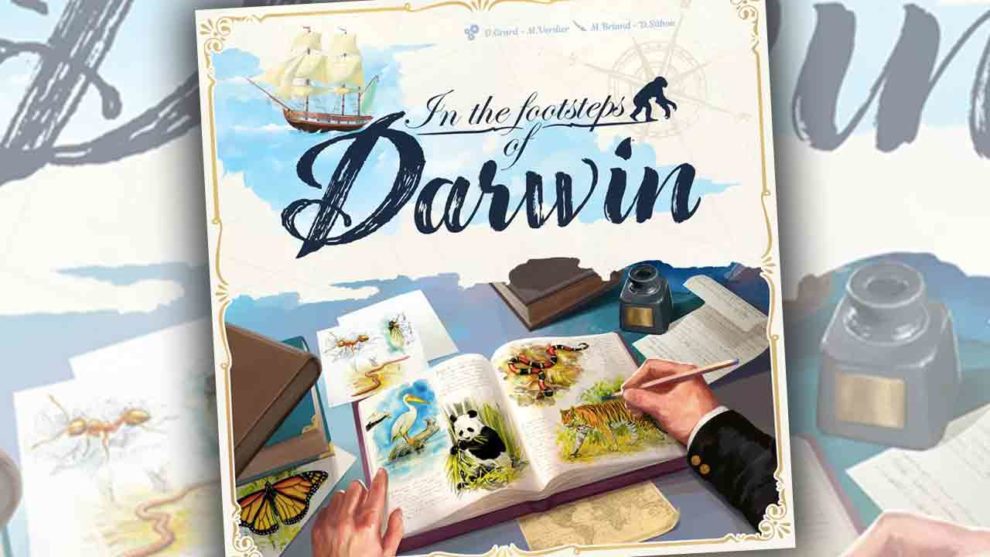



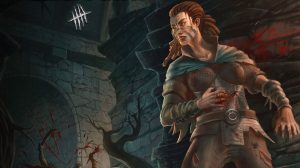
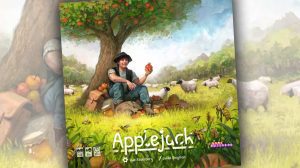




Add Comment